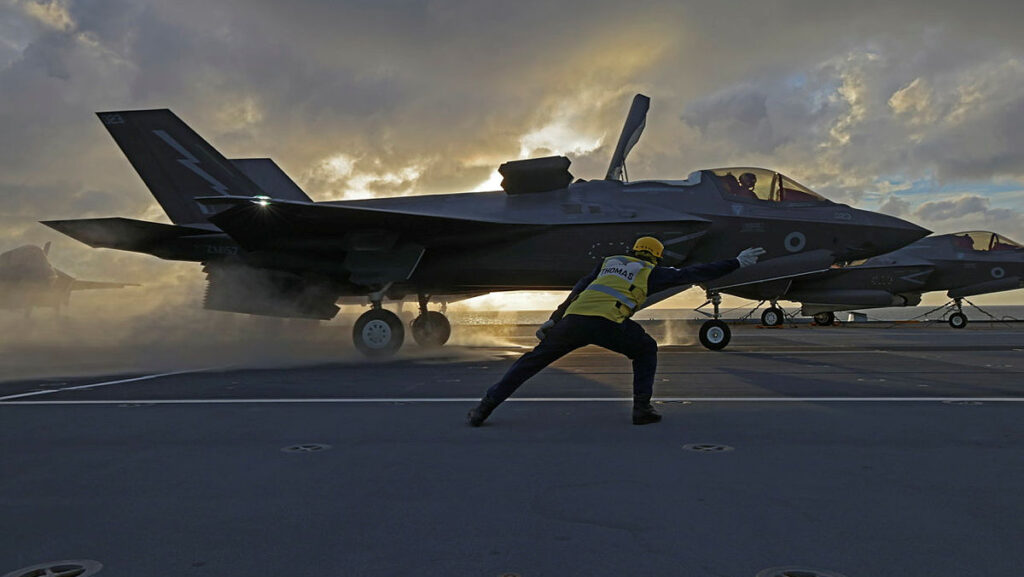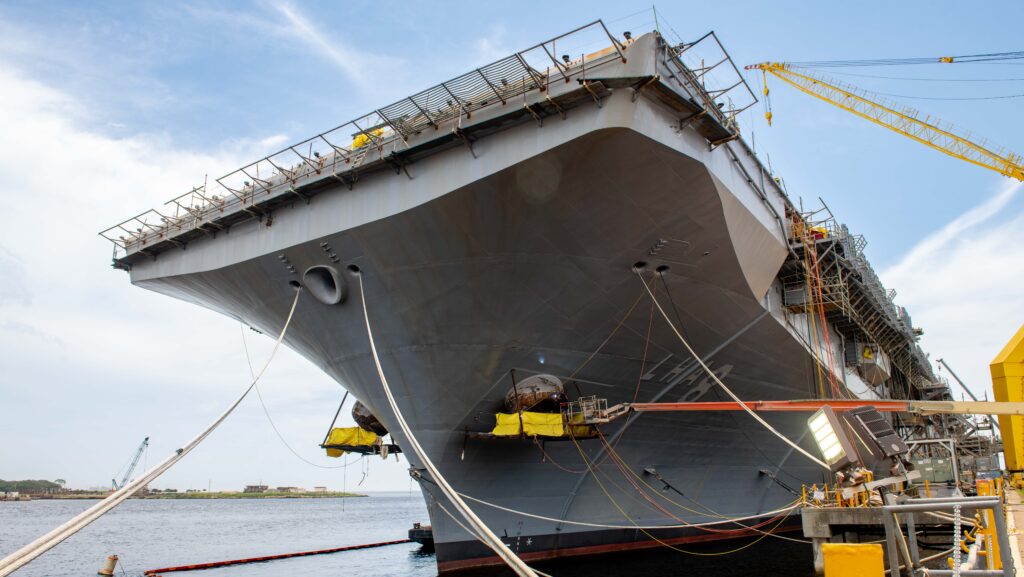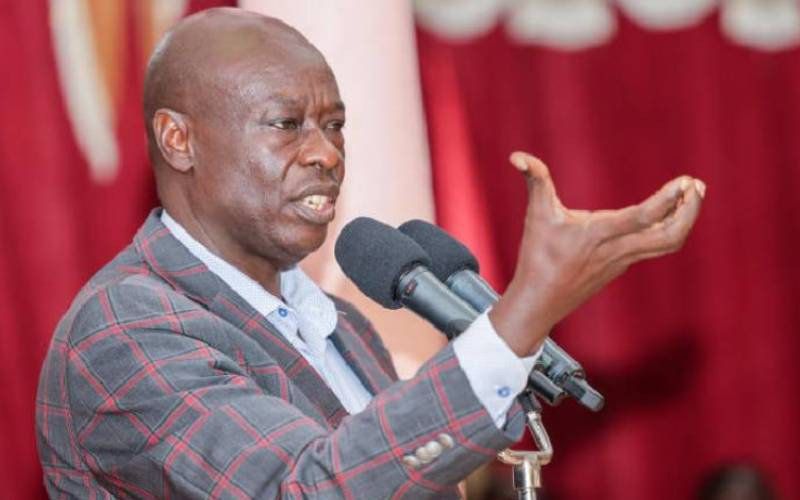F-35B fighter jets from the UK Carrier Strike Group launch from the HMS Queen Elizabeth aircraft carrier to undertake sorties under NATO command in the Atlantic (UK MoD)
BELFAST — As the United Kingdom counts down to a general election on July 4, the center-left Labour Party looks on course to return to power for the first time in 14 years, and do so, according to opinion polls, with a commanding majority of around 200 to 256 parliamentary seats.
Which raises the obvious question of how a Labour government will differentiate itself from the Tories on defense. If public statements in recent months are to be believed, analysts seems to say the answer is: Largely staying the course, but with increased ties back to Europe.
Several Tory prime ministers, and incumbent Rishi Sunak in particular, have made supporting Ukraine a key focus of its international policy. Labour seems poised to continue that support, which will be welcome news in Kyiv.
Other key pledges from Labour leaders include defense spending reaching 2.5 percent GDP as soon as possible — albeit with a clause that Labour’s own fiscal rules must be met — as well as cast iron support for the UK’s Continuous At Sea Deterrent (CASD) and NATO, rebuilding relations with the European Union and completion of a new strategic defense review by July 2025.
Under leader Keir Starmer, Labour has cast aside criticism by rival political parties that it is weak on defense policy, making efforts to distance the party from two highly controversial policies shared by Starmer’s pacifist predecessor Jeremy Corbyn: support for nuclear disarmament and the disbanding of NATO.
In the build up to the election, Starmer said that the CASD, provided by Royal Navy Vanguard-class nuclear-powered ballistic missile submarines (SSBN) fitted with Trident 2 D5 warheads, “is the foundation of any plan to keep Britain safe,” and that Labour’s commitment to it will be “absolute.”
Earlier this month, he further demonstrated Labour’s clean break from nuclear disarmament sympathies when he explained, “We would have to be prepared to use it [the nuclear deterrent]” to defend the UK, if circumstances ever required such a decision to be made.”
Starmer has also promised to continue with the estimated £31 billion ($39 billion) acquisition of four Dreadnought-class submarines, expected to succeed the Vanguard fleet from 2030 onward.
“The UK’s submarine enterprise is entering a phase of acute demand convergence, with open build pipeline for both SSN (Attack) and SSBN (Ballistic) submarine families overlayed, alongside the UK’s sizeable commitments to the AUKUS trilateral partnership,” said Stuart Dee, a research leader in defense at RAND Europe.
“For governments of any political persuasion, key challenges in this endeavor will be managing the criticality of infrastructure on a small number of key industrial sites,” including in Barrow-in-Furness, Cumbria, where BAE build the vessels, “managing cost and relevance of outcomes in these complex, multi-decade programmes whilst continuing to attract the skilled workforce into the industrial base.”
Striking a balance between the huge costs involved in delivering SSBNs and funding acquisition of conventional weapons, demands that “money has to be spent better” by Labour, if it is to end a cycle of “waste” tied to the UK military procurement system, judged “at a minimum” to be squandering an estimated “£2.2 billion ($2.8 billion), could be as high as £3.2 billion” ($4 billion) per year, according to Francis Tusa, a UK defense expert.
In a November 2023 defense equipment plan report [PDF], the UK National Audit Office forecast that over the next decade, the cost of supporting the nuclear deterrent alone will “exceed budget by £7.9 billion,” ($10 billion).
Defense Spending Pledges
While the 2.5 percent GDP target effectively amounts to a pledge to keep defense spending steady, several analysts looked sideways at Labour’s failure to commit to a firm timeline on achieving the target because the Conservative Party is similarly devoted to reaching the same goal by 2030.
“The fact that they [Labour] haven’t made the same commitment [as the Conservative Party] is slightly interesting, because I don’t really see that they will have much of a choice as 2.5 percent will become the de facto target,” said Tim Lawrenson, a European defense expert. “I wouldn’t be surprised if it is announced at the NATO Summit in Washington.”
He added that, “given the commitments Labour have made to the [nuclear] deterrent and AUKUS are going to be phenomenally expensive, they’re not going to do those things and maintain viable, conventional defenses,” without increased spending.
Irrespective of which party comes to power, any new government will face a number of “key challenges” in attempting to implement the 2.5% GDP target, said Dee.
The problem in doing so is “likely” to be based around “the extent to which existing cost/inflationary overruns are destined to ‘backfill’ a large element of this proposed funding uplift, and more broadly whether…capacity exists in the industrial base to meaningfully spend the uplift, given existing demographic and skills constraints and the need for capability-specific demand signals for industry to invest,” he explained.
Taking a more hard line perspective, Tusa said Labour’s 2.5% GDP declaration was “for the birds” or unrealistic because the party has not suggested “new money” will be secured once in office, underlined by ruling out income tax, VAT, corporation tax or national insurance contribution increases.
Elsewhere, Tusa welcomed Labour’s focus on rebuilding partnerships in Europe, which seemingly ends a Conservative push toward an “Indo-Pacific tilt,” and which could potentially lead to the UK and the European Union agreeing to a defense trade agreement. Such a scenario has not been politically relevant under the Conservatives because of the party’s delivery of Brexit, subsequently leading to Britain’s exclusion from EU defense programs.
“I think there are enough areas of agreement” for both sides to begin discussions, said Tusa. “Whether it would be one massive treaty or a number of little initiatives” is difficult to predict. As an example, he said that if smaller projects were to be agreed to, the Royal Navy could potentially be involved in EU naval missions, and the UK would certainly be capable of taking part in air and missile defense research and development projects.
“This very strong commitment to rebuild partnerships with [European] allies and the EU [European Union] is interesting,” said Lawrenson. “Labour’s position is probably more important than first thought because the EU, post invasion of Ukraine, has done a lot of new initiatives, and laid out policy instruments that increasingly act as a barrier to cooperation with the UK and make defense cooperation difficult.
“Whether they [Labour] will get what they want or whether the EU will be willing to co-operate remains to be seen but it is crazy that defense co-operation was not tied down in the original Brexit agreement, so they’ll [EU] at least be open to a discussion.”
Dee suggested that Labour’s unwavering support of NATO will “likely” be of “increasing significance” as allies “continue to deter Russia and collectively shape an ongoing support package” afforded to Ukraine since the start of the war.
“NATO’s long-discussed potential growth in focus to cohere economic responses to adversary positions in critical raw materials, for example, will also require buy-in from key allies beyond the US, which may further the importance of the UK’s continued presence and commitment to the alliance,” added Dee.
New Defense Minister
John Healey, Labour’s shadow defense minister, is the likeliest choice to lead the MoD under a new government. As an early order of business, he has promised to deliver the new strategic defense review “to get to grips with the threats that we face, the capabilities we need…and [make] the resources available,” according to a parliamentary speech in April.
To this point, Healey has not signaled which big ticket procurements could be protected or potentially face cancellation under a new Labour government, but he continues to accuse the Conservatives of wasting around £15 billion ($19 billion) on mismanaged acquisitions, while arguing that delays to the long troubled British Army Ajax and Royal Air Force E-7 Wedgetail AEW&C programs are putting UK NATO commitments at risk.
President Zelensky is right. If there is a change of Government to Labour on 4 July, there will be no change to Britain’s resolve to support Ukraine, confront Russian aggression and pursue Putin for his war crimes.
The UK is united in support of Ukraine. https://t.co/qWK812fEZH pic.twitter.com/HBFNSy1ocz
— John Healey (@JohnHealey_MP) May 31, 2024
Lately, Healey has also weighed in over troubles surrounding the MoD’s Morpheus effort, a key component of the British Army’s Land Environment Tactical Communications and Information Systems (LETacCIS) program.
Morpheus has been designed to source a successor to the outdated Bowman communication system, based around a state of the art, open source solution and for use with “forward headquarters, vehicles and on the soldier,” according to LETacCIS guidance documents.
Reacting today to a Financial Times report accusing the MoD of wasting almost £175 million ($221 million) on “external advice” to support Morpheus, Healy said on X (formerly Twitter), that the debacle, “is the latest in a line of failures that has seen Tory Ministers blowing millions whilst hollowing out our Armed Forces.”
Morpheus was thrown into disarray when the UK prematurely ended an Evolve to Open Transition Partner contract, valued at £330 million ($418 million) with General Dynamics UK (GDUK) in December 2023. London said at the time that GDUK had failed to “deliver a lab tested design” against a three-year timeframe.
As a result of delays, Morpheus will not enter service as expected in 2025 and it could be more than a decade before such a target is met: James Cartlidge, UK minister for defence procurement said in January that Bowman’s out of service date had been “extended out to no later than 2035, and no earlier than 2031, to bridge the capability gap until Morpheus delivers.”
Healey has also been scathing of cuts to the British Army, based on an original target from the Conservatives to reduce the service to 73,000 by 2025, its smallest size since the Napoleonic Wars. As of April1 , UK MoD personnel figures showed that the British Army stood at 72,510 Full-Time Trade Trained Strength (FTTTS) soldiers, demonstrating that the 73,000 ambition has been eclipsed by a faltering trend in recruitment and retention.
Once again, however, there doesn’t appear to be any clear solution put forth by Healey’s party: “Labour has not made any direct [commitments], beyond the obvious of saying ‘the army isn’t large enough,’” said Tusa.
Lawrenson said that any eventual target put forward by Labour, is “likely” to be shared once the new strategic review is completed, “and to some extent it will depend on the international security situation at the time and will be another year or just over, where the situation between Russia and Ukraine might drive a different mindset on what needs to be done,” where numbers are concerned.
“I think they [Labour] have tried to keep their powder dry for the moment, but they will at the least have to try and stem the turnover in personnel and numbers of people leaving the armed forces,” he explained.
Dee echoed a similar view. He added that, “recruitment and retention challenges shared across both armed forces and the defence industry more broadly are likely to remain pervasively difficult to tackle.”




















Discussion about this post